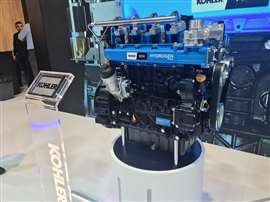Using alternative fuels to ensure the availability of mission-critical power in today’s world
11 January 2024
Global pressures on electricity networks mean mission-critical system operators rely on backup power more than ever. Proven equipment can combine with emerging technologies for improved resiliency.
That we live in an unpredictable world is as true now as it has ever been. From extreme weather events to climate change to global instabilities, electricity networks are under intense pressure, leading to power cuts, blackouts and price rises in many countries.
For mission-critical power users such as hospitals, airports, data centers and water treatment plants, grid instability can cause severe operational problems and even threaten life. These facilities need dependable power 24/7/365. That typically requires the use of backup generators — individual units up to 4 MW in size in various configuration — to provide resiliency.
 The Kohler KDH H2 IC engine will help reduce carbon emissions. (Photo: Power Progress International)
The Kohler KDH H2 IC engine will help reduce carbon emissions. (Photo: Power Progress International)
Historically, gensets such as these have been driven by diesel or gaseous fuel. Geopolitical concerns, however, have caused spikes in oil and gas prices. Regulatory restrictions focused on the reduction of emissions to combat climate change must also be considered. These limitations have resulted in fossil fuels being phased out, causing generator manufacturers to explore more sustainable options. Fortunately, there have been rapid developments in renewable fuels, many of which are suitable for emergency power generation.
HVO Shows Promise
Adopting hydrotreated vegetable oil (HVO), also called renewable diesel, is one such fuel choice. The refining process for HVO means chemically it is almost identical to diesel, However, it is significantly cleaner-burning. HVO can reduce net carbon dioxide (CO2) emissions by as much as 90%.
Generator users can deploy HVO in new and existing diesel engine-powered generators, as the engines require no adaptations to operate on HVO fuel. This is true for Kohler generators, such as those in the KD Series. HVO can be mixed with traditional diesel in any blend. It is highly stable, with no risk of oxidation, meaning it can be stored much longer than traditional diesel with no need for fuel polishing. These credentials make HVO an attractive alternative to conventional fossil diesel, providing an environmentally friendly and regulatory-compliant option for end users while ensuring electric power availability.
Hydrogen in ICE
Then there is hydrogen – a promising technology that has been around for many years. Like HVO, hydrogen fuel can be used with conventional diesel engine technology, although the engines must be modified to burn hydrogen fuel. Such is the case with the KDH engine Kohler recently launched. Onboard fuel tanks for hydrogen are also different from traditional gasoline or diesel tanks.
Hydrogen must be captured from renewable energy and other low-carbon sources to offer a genuinely sustainable solution. Since low-carbon sources have not been widely adopted, the ability to generate so-called green hydrogen has been limited. Some technologies are coming to market now that are making green hydrogen available, but it needs to be ramped up to make it commercially viable.
Furthermore, there can be technical drawbacks with hydrogen systems, such as start-up time and the ability to manage significant changes in load. Therefore, while hydrogen is another promising technology, it needs more infrastructure and development to become a substantial supply contributor in a resilient energy landscape.
Leveraging Emerging Tech
For customers wanting to adopt emerging technologies, it is important to balance them with proven solutions. Solar power generation in the form of photovoltaics (solar panels and batteries) is a proven technology that continues to be adopted globally. There is no doubt that it can help drive down emissions and energy costs.
The challenge with solar, though, is intermittency. It only produces energy during the day, and output can vary dramatically depending on the month, hour and intensity of the sun’s rays. While batteries can store energy for use on demand, they can be depleted if demand is high or if there is a lack of sunshine. Thus, solar power alone is not a resilient enough energy source. However, it is now possible to pair photovoltaics with a generator to take advantage of cleaner, renewable technologies while ensuring that resilient power is in place even if the sun does not shine and the batteries are depleted.
Finding a Balance
New technologies will play a role in both helping address emissions concerns and meeting the demands of mission-critical end users. There is no “one size fits all.” Each method has strengths and weaknesses, and resiliency can only be assured by adopting the right mix of technologies, including proven equipment such as generators.
POWER SOURCING GUIDE
The trusted reference and buyer’s guide for 83 years
The original “desktop search engine,” guiding nearly 10,000 users in more than 90 countries it is the primary reference for specifications and details on all the components that go into engine systems.
Visit Now
STAY CONNECTED




Receive the information you need when you need it through our world-leading magazines, newsletters and daily briefings.
CONNECT WITH THE TEAM









